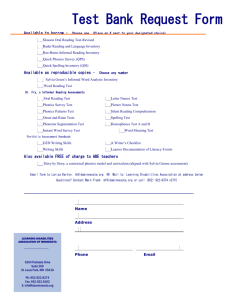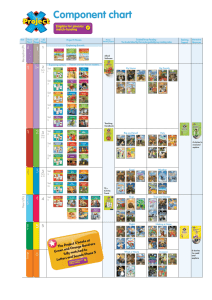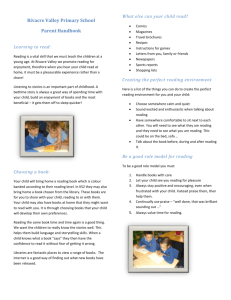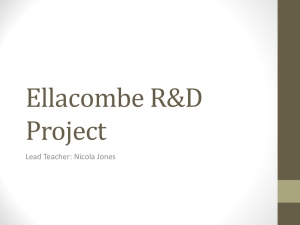PowerPoint - Curry School of Education
advertisement
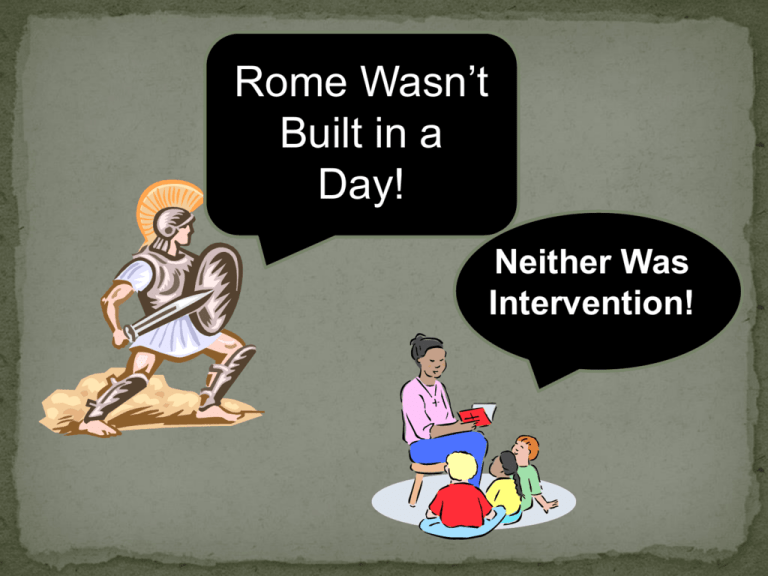
Rome Wasn’t Built in a Day! Neither Was Intervention! How We Started Year One DIBELS Informal Assessments: - Fry - S.T.A.R. - Wright Group Leveled Reading Assessment What We Learned from Data: Year One Kindergarten ISF low mid-year PSF low end-of-year LNF on target NWF low end-of-year Fry – did not administer S.T.A.R. – administered to above average students per teacher recommendation Reading Level Assessment – not given What We Learned from Data: Year One First Grade Mid-year NWF went down PSF on target LNF on target End-of-year ORF low Fry: low Reading Level Assessment – many below grade level S.T.A.R.: many below grade level What We Learned from Data: Year One Second Grade NWF low Students either regressed or showed no movement in ORF Reading level slight increase S.T.A.R. slight increase Fry increase What We Learned from Data: Year One Third Grade ORF benchmark continued to improve; strategic and intensive – little or no movement S.T.A.R. minimal growth Fry increase Meeting the Needs • • • • • • Small-group Instruction K, 1- Road to the Code PA/Phonics strategies from core and Teacher Academy materials 2, 3 – Fluency using intervention materials from core Assisted Reading Pulled 1st grade phonics lessons 1, 2 – Failure Free (sight words) • • Intervention K, 1 – Early Reading Intervention (Scott Foresman) 2, 3 – Read Naturally Year One Generalizations • • • • • Implemented Progress monitoring record keeping system too late First Grade ORF low due to lack of monitoring NWF Overemphasized Fry list (1)/realized needed to administer Fry in K Slight increase in reading levels resulted from lack of firm phonics foundation Overemphasis on ORF scores at the expense of firm phonics foundation Realized there was not enough data to determine specific phonics deficiencies Year One Generalizations • • • PSF scores in First Grade indicated Road to the Code no longer needed Realized need for higher level phonics intervention for 1 Realized need for intervention program to address phonics deficits in 2 and 3 Where We Went Next: Year Two • • • Realized that teachers in 2 and 3 needed additional support in the teaching of phonics Administered Informal Phonics Survey Struggling students in 3: Administered Test of Knowledge of Onsets, Z-test, Developmental Test of Word Recognition to differentiate smallgroup instruction Meeting the Needs • • • • • Small-group K- continue Road to the Code; PA/Phonics from Teacher Academy and core 1 - PA/Phonics from Teacher Academy and core 2,3 – used IPI data to plan lessons in phonics (based on grade 1 core scope and sequence) 2 – Core intervention manual for fluency lessons 2, 3 – Comprehension Plus Intervention • • • • K- Early Reading Intervention 1 - Early Reading Intervention (intensives); Early Intervention in Reading (strategic) 2 - Voyager; Read Naturally 3 - Corrective Reading; Read Naturally Year Two Generalizations • • • • • Comprehension needed more focus Fluency suffered due to overemphasis on phonics – needed to balance Began to notice lack of Print and Book Awareness skills in 1 Data from CRCT and ITBS indicated spelling skills were deficient Realized importance of students’ assessment history as students moved from grade to grade Where We Went Next Year Three DIBELS – included RTF Informal Assessments: - Fry - Informal Phonics Survey - Developmental Spelling Assessment - Wright Group Leveled Reading Assessment - S.T.A.R. - Informal Reading Inventory - Open Court Print Book Awareness (K) - Johns Basic Reading Inventory – Listening Comprehension mid-year (K) Strugglers: Z-test, Developmental Test of Word Recognition, Test of Knowledge of Onsets Meeting the Needs • • • • • • Small-group K - 3 Word Study (Words Their Way sorts) K - continue Road to the Code; PA/Phonics from Teacher Academy and core 1 - PA/Phonics from Teacher Academy and core; modified Read Naturally 2,3 - used IPI data to plan lessons in phonics (based on grade1core scope and sequence) 2 - core intervention manual for fluency lessons 2, 3 - Comprehension Plus Intervention K - Early Reading Intervention 1 - Early Reading Intervention, Early Intervention in Reading 2, 3 - Voyager; Read Naturally Year Three Generalizations • • • • Listening Comprehension needed to be assessed at the beginning of the year - K Print Book Awareness assessment yielded positive results due to emphasis on the skills involved Realized new grade 1 students needed basic K assessments Word Study not effectively implemented – needed more training for teachers Where We Are Now: Year Four • • • Fully implementing Words Their Way word study based on DSA results (to address all levels) K – addressing oral language vocabulary based on Peabody results 1 – bridging NWF and ORF through lesson pacing JCES 3rd Grade Intervention 06-07 September 2006 ( 2:25-2:55) VOYAGER Read Naturally Teacher/ # students Parapro/# students Fortner 6 Carol Parapro # students 6 Marida 6 Brandterion (HH)2.3 but move up quickly Wade Tykendrick Tyrone 2.3 but move quickly up Lamonka t (HH) 2.3 Jasmine JaQuandrick (F) 3.5 Cortlen e (HH) 3.5 T’Mai D’Mario (F) 3.5 Special t (Couey) 2.3 Jamorice Jamari (F) 3.5 Mara s (Snead) 2.3 Wiley Clark Jalen (F) 2.3 but move up quickly Parapro Day Reading Parapro 8:05-8:25—Word Study Groups 5th grade 8:25-9:25—Small Group First Grade 9:30-10:30—Small group 2nd grade 10:30-10:40—break th 10:40-11:15 –lunch duty 4 grade rd 11:15-12:15—3 grade small group 12:15-12:45—2nd grade intervention 12:50-1:20—lunch 1:20-1:55—Math 5th grade 1:55-2:25—Intervention 1st grade rd 2:25-2:55—Intervention 3 grade Intervention Caveat Intervention is not permanent! Remember “The purpose of providing extra instructional time is to help children achieve levels of literacy that will enable them to be successful through their school careers and beyond.” (Snow, Burns, & Griffin, 1998, p. 247) Remember this! If you don’t start none, there ain’t gonna be none.


